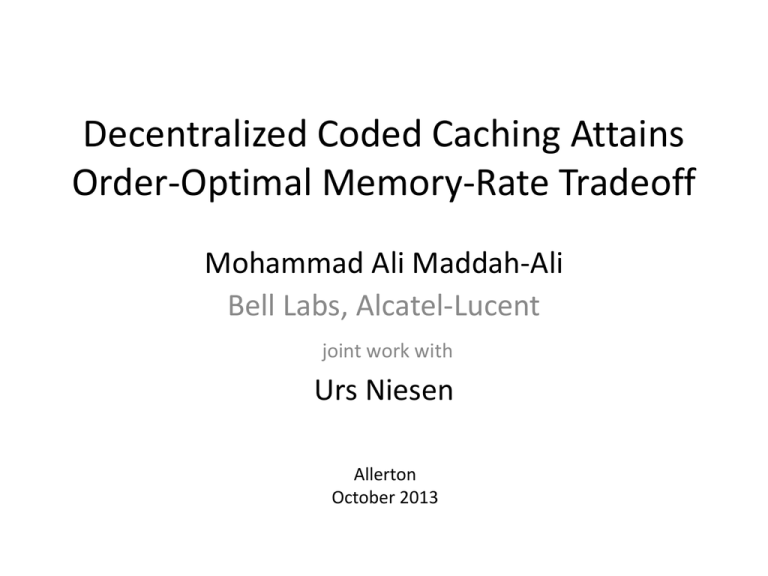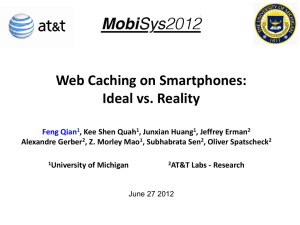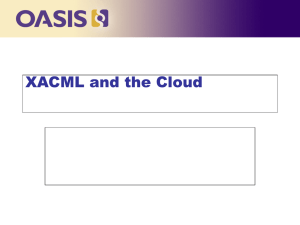Caching: A New Vision - ECT
advertisement

Decentralized Coded Caching Attains Order-Optimal Memory-Rate Tradeoff Mohammad Ali Maddah-Ali Bell Labs, Alcatel-Lucent joint work with Urs Niesen Allerton October 2013 Video on Demand Normalized Demand 100 80 60 40 20 0 0 2 4 6 8 10 12 14 16 18 20 22 Time • High temporal traffic variability • Caching (prefetching) can help to smooth traffic Caching (Prefetching) Server • Placement phase: populate caches • Demands are not known yet • Delivery phase: reveal request, deliver content Problem Setting Server N Files Shared Link K Users Cache Contents Size M Placement: Delivery:Smallest - Cacheworst-case arbitrary function the filesin (linear, nonlinear, -Requests are revealed toR(M) theof server Question: rate needed delivery phase?…) How to choose (1) caching delivery functions - Server sends a functions, function of (2) the files Coded Caching N Files, K Users, Cache Size M • Uncoded Caching • Caches used to deliver content locally • Local cache size matters • Coded Caching [Maddah-Ali, Niesen 2012] • The main gain in caching is global • Global cache size matters (even though caches are isolated) Centralized Coded Caching N=3 Files, K=3 Users, Cache Size M=2 Maddah-Ali, Niesen, 2012 A12 Approximately Optimum A13 A23 B12 B13 B23 C12 C13 C23 A23 B13 A23⊕B13⊕C12 C12 1/3 A12 B12 C12 A12 B12 C12 A13 B13 C13 A13 B13 C13 A23 B23 C23 A23 B23 C23 Multicasting Opportunity between three users with different demands Centralized Coded Caching N=3 Files, K=3 Users, Cache Size M=2 A12 • Centralized caching needs • Number and identity of the users in advance A13 A23 B12 B13 B23 C12 C13 C23 • In practice, it is not the case, • Users may turn off • Users may be asynchronous • Topology may time-varying (wireless) A12 B12 C12 A12 B12 C12 A13 B13 C13 A13 B13 C13 A23 B23 C23 A23 B23 C23 Question: Can we achieve similar gain without such knowledge? Decentralized Proposed Scheme N=3 Files, K=3 Users, Cache Size M=2 0 1 2 3 12 13 23 123 0 1 2 3 12 13 23 123 0 1 2 3 12 13 23 123 Delivery: Prefetching: Greedy Eachlinear user caches encoding 2/3 of the bits of each file - randomly, - uniformly, - independently. 23 ⊕ 13 ⊕ 12 1 ⊕ 2 2 ⊕ 3 1 ⊕ 3 0 0 0 1 12 13 123 2 12 23 123 3 13 23 123 1 12 13 123 2 12 23 123 3 13 23 123 1 12 13 123 2 12 23 123 3 13 23 123 Decentralized Caching Decentralized Caching Centralized Prefetching: 12 13 23 12 13 23 12 13 23 Decentralized Prefetching: 0 1 2 3 12 13 23 123 0 1 2 3 12 13 23 123 0 1 2 3 12 13 23 123 Comparison N Files, K Users, Cache Size M Uncoded Local Cache Gain: • Proportional to local cache size • Offers minor gain Coded (Centralized): [Maddah-Ali, Niesen, 2012] Global Cache Gain: • Proportional to global cache size Coded (Decentralized) • Offers gain in the order of number of users Can We Do Better? Theorem: The proposed scheme is optimum within a constant factor in rate. • Information-theoretic bound • The constant gap is uniform in the problem parameters • No significant gains beside local and global Asynchronous Delivery Segment 1 Segment 2 Segment 3 Segment 1 Segment 2 Segment 3 Segment 1 Segment 2 Segment 3 Conclusion • We can achieve within a constant factor of the optimum caching performance through • Decentralized and uncoded prefetching • Greedy and linearly coded delivery • Significant improvement over uncoded caching schemes • Reduction in rate up to order of number of users • Papers available on arXiv: • Maddah-Ali and Niesen: Fundamental Limits of Caching (Sept. 2012) • Maddah-Ali and Niesen: Decentralized Coded Caching Attains Order-Optimal MemoryRate Tradeoff ( Jan. 2013) • Niesen and Maddah-Ali: Coded Caching with Nonuniform Demands (Aug. 2013)








